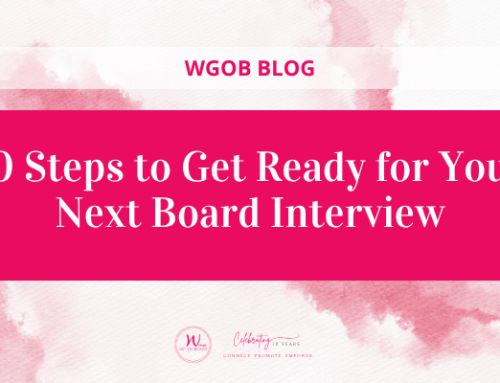If you have successfully secured a corporate board seat, the next step in your journey is to take on a leadership role within the board. However, just like in your professional career, reaching a leadership position in the boardroom requires gaining experience and developing your skills.
Looking to elevate your board leadership? Improving your board leadership skills involves ongoing learning, personal growth, and building strong relationships. We suggest these 10 practical steps to support your development.
1. Continuous Learning
Stay informed about industry trends, emerging governance practices, and economic changes that could affect your organization. Reading books, articles, and reports on the latest governance developments is a great way to stay updated, as is participating in workshops, webinars, and conferences focused on governance. We also recommend enrolling in online courses or certification programs to expand your knowledge (refer to our WGOB E-Guide to Board Leadership and Development Programs for suggestions).
2. Gain Experience
Serving on a volunteer board offers valuable insights and experience that can be useful in corporate governance. When possible, consider seeking opportunities to observe and learn from experienced board leaders, allowing you to benefit from their expertise.
3. Build Resilience
Resilience has always been a vital leadership skill, but as uncertainty and change rise globally, it has become even more essential. To lead effectively on a board, be ready to adapt to ongoing change. When a management team and a board commit to fostering a culture of agility, innovation, and resilience, success usually follows.
4. Develop a Diverse Network
Build relationships with a broad network of board leaders and governance professionals to exchange insights and learn from their experiences.
5. Adopt a Strategic Mindset
Recently, conventional thinking around governance has begun to move beyond ensuring mere compliance to embracing a strategic mindset. While boards are responsible for numerous regulatory and internal compliance tasks, the actual value that boardroom leaders provide lies in their foresight, scenario planning, and ability to adapt to new environments. To enhance your board leadership, move beyond simply ticking boxes and instead focus on anticipating challenges and opportunities on the horizon.
6. Enhance your Emotional Intelligence (EI)
Gain a deeper understanding of your own emotions and those of others. Improving your EI can enhance social interactions and support better decision-making. Empathetic board members are kind, considerate, fair, and even-handed. They can forgive others—and themselves—for past mistakes. In the boardroom, they build trust by treating management and fellow board members with respect and compassion. Refer to our WGOB E-Guide to Emotional Intelligence in the Boardroom for more insights.
7. Seek Feedback and Self-Reflect
Seek feedback from peers and mentors. Reflect on your leadership approach and identify areas for development. Use this feedback to make informed improvements.
8. Enhance Decision-Making Skills
Continuously develop your critical thinking skills to contribute value to boardroom discussions. Examine and assess the data you receive with an analytical approach to make well-informed, timely decisions.
9. Promote Diversity and Inclusion
Intentionally support increased diversity around the boardroom table and encourage inclusive practices. Strong board leaders recognize that including a range of perspectives on the board enriches discussions and leads to well-rounded decision-making.
10. Lead With Courage
Leading with courage allows you to confidently face challenges in the boardroom, promote a culture of integrity and resilience, and create a successful business environment. Courageous leaders are characterized by their ability and willingness to speak up on critical issues, ensuring the organization prioritizes the best interests of all stakeholders while promoting innovation and growth.






